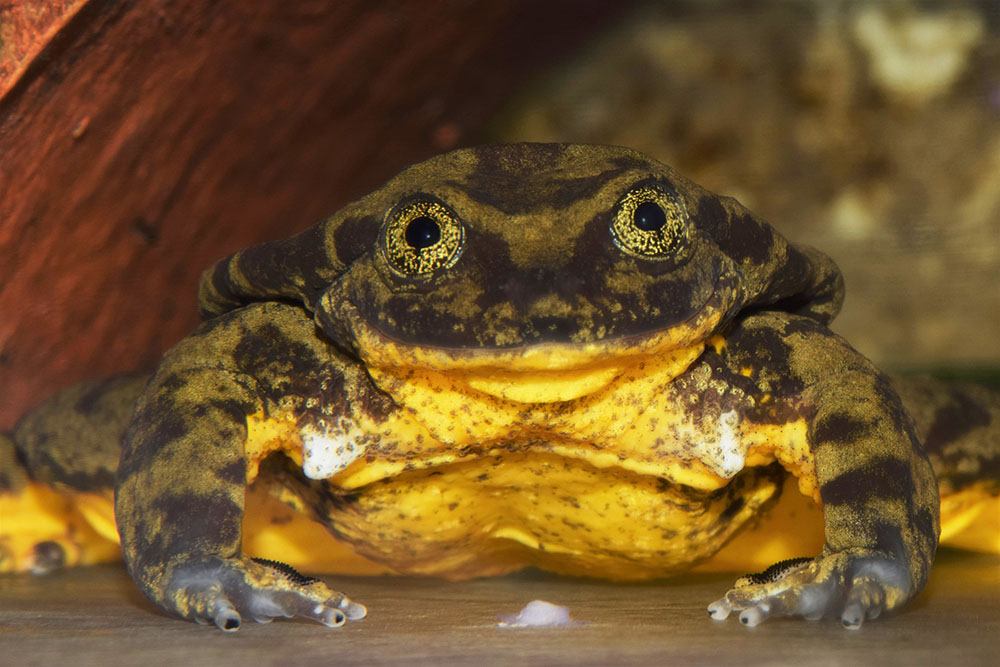
With his intricately-patterned skin, bright orange underbelly, and bulging emerald eyes, Romeo, a male Sehuencas water frog, should have had no trouble finding a mate. The only problem? Until recently, the world’s most eligible amphibious bachelor was believed to be the last surviving member of his kind! Now, just in time for Valentine's Day, researchers may have found the perfect Juliet for this modern-day Romeo!
"When biologists collected Romeo 10 years ago, we knew the Sehuencas water frog, like other amphibians in Bolivia, was in trouble, but we had no idea we wouldn’t be able to find a single other individual in all this time,” said Arturo Muñoz, founder of the Bolivian Amphibian Initiative. About 12 months after residing in an aquarium at Bolivia’s Natural History Museum, Romeo began calling out for a mate. However, as the years have gone by, the world's loneliest frog has become increasingly less vocal, causing researchers to worry that he is losing all hope of ever finding love.

To help the lonely amphibian, on Valentine's Day 2018, the museum's officials, in collaboration with the Global Wildlife Conservation, put Romeo's profile on Match.com, an online matchmaking website. While his dashing good looks did not attract any female frogs, they did help raise $25,000 to fund several search expeditions to Bolivia's cloud forests, the Sehuencas water frog's native habitat.
Since then, a team, led by the museum's chief of herpetology Teresa Camacho Badani, has been searching for specimens of the elusive frogs in areas they have been found in the past and ones that appear to have the right conditions. The scientists' hard work finally paid off on January 15, 2019.
"We were tired, wet and disappointed," said Badani, who believes that climate change and the contaminated waterways of Bolivia have driven the Sehuencas water frog, and 22 other frog species, close to extinction. "Then I said, 'Let's do one more creek.'"

Sure enough, close to the creek's waterfall, the researcher noticed a frog jump up. “When I pulled it out, I saw an orange belly and suddenly realized I had in my hands the long-awaited Sehuencas water frog,” Badani told The Guardian. “My first reaction was to yell, 'I found one!' The team came running over to help me and pull the frog to safety. It was an incredible feeling.”
Upon examining the amphibian closely, the scientists realized it was a male frog. But they were not deterred. "I noticed the habitat was in good condition, so we had hope," said Badani. They returned the following day and after a painstaking search, which involved immersing their hands into the cold creek water several times to feel for the hard-to-spot frogs, found four more specimens — two females and two males. While three were too young, one female, instantly named Juliet, was the perfect age for Romeo.

All four frogs are currently in quarantine to allow them to acclimatize to their captive environment, which has been designed to replicate their natural habitat. They will also be checked to ensure that they are disease-free. Whether Romeo and Juliet will be compatible remains to be seen. However, Badani is cautiously optimistic. The researcher told globalwildlife.org, "She [Juliet] likes worms as much as Romeo likes them! She is very strong and swims very fast. She looks great and is healthy. Opposites attract—while Romeo is very shy, Juliet is not at all! So we think she will make an excellent match for Romeo."
The researchers plan to continue scouring the forests for more wild specimens until March 2019. They hope new discoveries, along with Romeo and Juliet and the other recently-found younger frogs, will allow them to revive the Sehuencas water frog population.
Resources: NPR.org, smithsonianmag.com,globalwildlife.org
